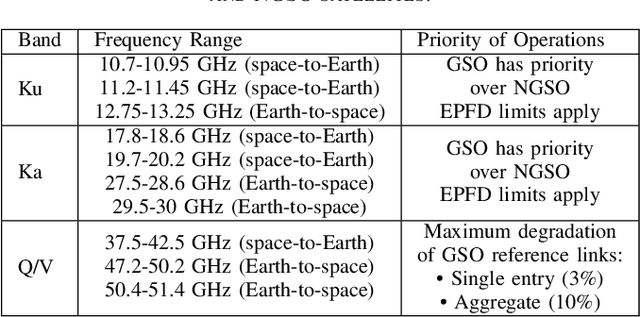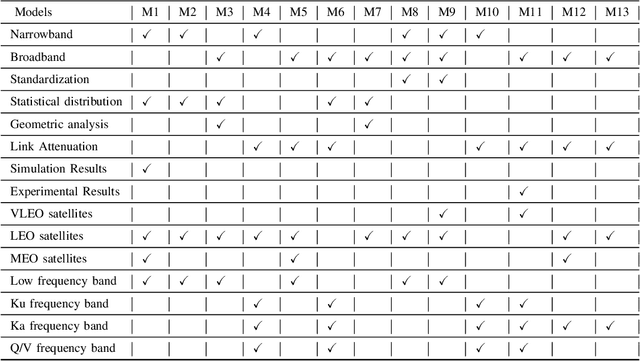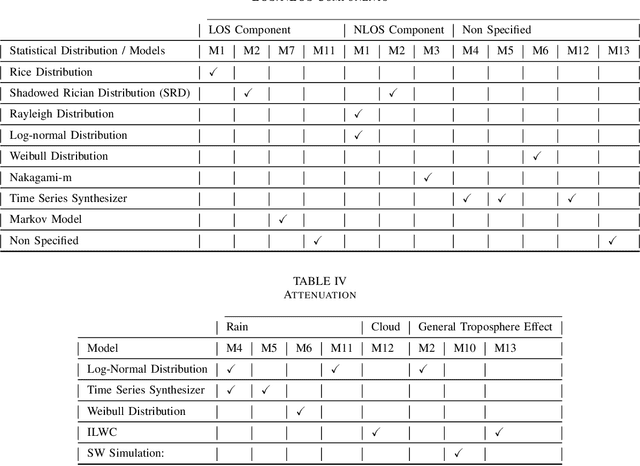Victor Monzon Baeza
Enabling Continuous 5G Connectivity in Aircraft through Low Earth Orbit Satellites
Apr 09, 2025



Abstract:As air travel demand increases, uninterrupted high-speed internet access becomes essential. However, current satellite-based systems face latency and connectivity challenges. While prior research has focused on terrestrial 5G and geostationary satellites, there is a gap in optimizing Low Earth Orbit (LEO)-based 5G systems for aircraft. This study evaluates the feasibility of deployment strategies and improving signal quality with LEO satellites for seamless in-flight 5G connectivity. Using Matlab and Simulink, we model satellite trajectories, aircraft movement, and handover mechanisms, complemented by ray-tracing techniques for in-cabin signal analysis. Results show that proposed LEO satellite configurations enhance coverage and reduce latency, with sequential handovers minimizing service interruptions. These findings contribute to advancing in-flight 5G networks, improving passenger experience, and supporting real-time global connectivity solutions.
AI-Driven Tactical Communications and Networking for Defense: A Survey and Emerging Trends
Apr 07, 2025Abstract:The integration of Artificial Intelligence (AI) in military communications and networking is reshaping modern defense strategies, enhancing secure data exchange, real-time situational awareness, and autonomous decision-making. This survey explores how AI-driven technologies improve tactical communication networks, radar-based data transmission, UAV-assisted relay systems, and electronic warfare resilience. The study highlights AI applications in adaptive signal processing, multi-agent coordination for network optimization, radar-assisted target tracking, and AI-driven electronic countermeasures. Our work introduces a novel three-criteria evaluation methodology. It systematically assesses AI applications based on general system objectives, communications constraints in the military domain, and critical tactical environmental factors. We analyze key AI techniques for different types of learning applied to multi-domain network interoperability and distributed data information fusion in military operations. We also address challenges such as adversarial AI threats, the real-time adaptability of autonomous communication networks, and the limitations of current AI models under battlefield conditions. Finally, we discuss emerging trends in self-healing networks, AI-augmented decision support systems, and intelligent spectrum allocation. We provide a structured roadmap for future AI-driven defense communications and networking research.
Supervised Learning Based Real-Time Adaptive Beamforming On-board Multibeam Satellites
Nov 02, 2023

Abstract:Satellite communications (SatCom) are crucial for global connectivity, especially in the era of emerging technologies like 6G and narrowing the digital divide. Traditional SatCom systems struggle with efficient resource management due to static multibeam configurations, hindering quality of service (QoS) amidst dynamic traffic demands. This paper introduces an innovative solution - real-time adaptive beamforming on multibeam satellites with software-defined payloads in geostationary orbit (GEO). Utilizing a Direct Radiating Array (DRA) with circular polarization in the 17.7 - 20.2 GHz band, the paper outlines DRA design and a supervised learning-based algorithm for on-board beamforming. This adaptive approach not only meets precise beam projection needs but also dynamically adjusts beamwidth, minimizes sidelobe levels (SLL), and optimizes effective isotropic radiated power (EIRP).
Flexible Payload Configuration for Satellites using Machine Learning
Oct 18, 2023Abstract:Satellite communications, essential for modern connectivity, extend access to maritime, aeronautical, and remote areas where terrestrial networks are unfeasible. Current GEO systems distribute power and bandwidth uniformly across beams using multi-beam footprints with fractional frequency reuse. However, recent research reveals the limitations of this approach in heterogeneous traffic scenarios, leading to inefficiencies. To address this, this paper presents a machine learning (ML)-based approach to Radio Resource Management (RRM). We treat the RRM task as a regression ML problem, integrating RRM objectives and constraints into the loss function that the ML algorithm aims at minimizing. Moreover, we introduce a context-aware ML metric that evaluates the ML model's performance but also considers the impact of its resource allocation decisions on the overall performance of the communication system.
Overview of Use Cases in Single Channel Full Duplex Techniques for Satellite Communication
Sep 29, 2023Abstract:This paper provides an overview of the diverse range of applications and use cases for Single-Channel Full-Duplex (SCFD) techniques within the field of satellite communication. SCFD, allowing simultaneous transmission and reception on a single frequency channel, presents a transformative approach to enhancing satellite communication systems. We select eight potential use cases with the objective of highlighting the substantial potential of SCFD techniques in revolutionizing SatCom across a multitude of critical domains. In addition, preliminary results from the qualitative assessment are shown. This work is carried out within the European Space Agency (ESA) ongoing activity FDSAT: Single Channel Full Duplex Techniques for Satellite Communications.
LiFi Technology Overview: taxonomy, and future directions
Mar 16, 2023Abstract:The looming electromagnetic spectrum crisis -- due to the fact of the explosive growth in the increasing user data demand -- has encouraged the emergence of new wireless technologies. This paper surveys the state-of-the-art leading and rapid developments in the current Light Fidelity (LiFi) technology. First, an overview is shown to help readers understand the potential of this technology. A comprehensive comparison with legacy wireless technologies is analyzed. We devise a taxonomy based on the main characteristics such as modulation techniques, applications, scenarios, network topologies, and architecture requirements, which enables a foundation for the research community. We highlight the powerful opportunities, the ongoing works, and results, identifying the challenges for future research.
Multiple Access in Constellation Domain by Non-Coherent Massive MIMO
Mar 11, 2023



Abstract:Multiple access is the base for increasing the capacity in multi-user communication networks. However, the growing demand for higher data rates and the number of users who requires communication services has led to the scarcity of orthogonal resources in current wireless communications. On the other hand, integrating the satellite within terrestrial networks as an initiative of 3GPP since its Release 15 entails the need for new forms of multiple access between terrestrial and non-terrestrial users. This paper studies constellation schemes as a new domain to enhance the state-of-the-art multiple-access techniques for future communication technologies employing non-coherent communications with massive MIMO. In addition, we propose a hybrid model between the classic access methods such as Time Division Multiple Access (TDMA) or Frequency Division Multiple Access (FDMA), the emerging models of non-orthogonal multiple access (NOMA) and the proposed domain of the constellation based on non-coherent massive multiple-input multiple-output (MIMO) schemes. This model is discussed for different scenarios in satellite communications that help increase the system's capacity and avoid interference between terrestrial and non-terrestrial users.
An Overview of Channel Models for NGSO Satellites
Sep 21, 2022



Abstract:Satellite communications industry is currently going through a rapid and profound transformation to adapt to the recent innovations and developments in the realm of non-geostationary orbit (NGSO) satellites. The growing popularity of NGSO systems, with cheap manufacturing and launching costs, has set to revolutionize the internet market. In this context, accurate channel characterization is crucial for the performance optimization and designing efficient NGSO communications, especially considering the dynamic propagation environment. While the Third Generation Partnership Project (3GPP) has provided some guidelines in Release 15, we observed certain divergence on the channel models considered in the literature, each with different assumptions and peculiarities. This paper provides an extensive review of the existing methods proposed for NGSO channel modeling that consider different orbits, frequency bands, user equipment, use-case and scenario peculiarities. The provided review discusses the channel modeling efforts from a contemporary perspective through trade-off analyses, classifications, and highlighting their advantages and pitfalls. The main goal is to provide a comprehensive overview of NGSO channel models to facilitate the selection of the most appropriate channel based on the scenario requirements to be evaluated and/or analysed.
 Add to Chrome
Add to Chrome Add to Firefox
Add to Firefox Add to Edge
Add to Edge